Coq au Vin
This post may contain affiliate links. Read my full disclosure policy.
Rich and full of flavor, coq au vin is a classic French stew with tender chicken braised in red wine. It’s the perfect dish to warm you up on a chilly day.
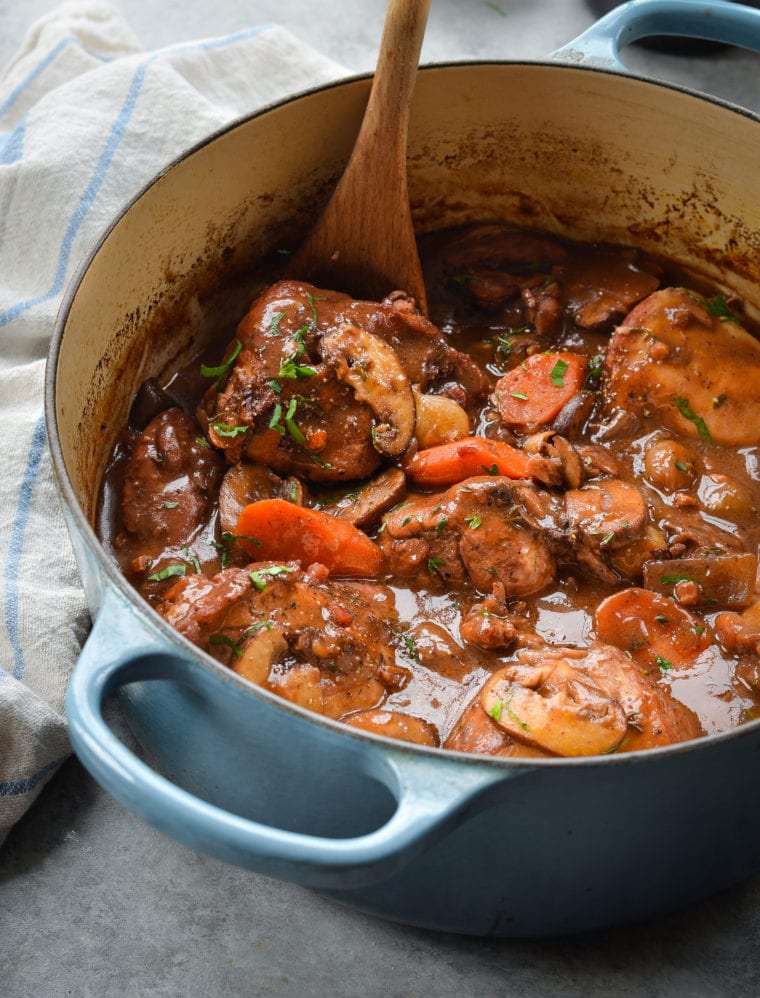
Rich and brimming with flavor, coq au vin (which translates to “chicken in wine”) is a classic French stew from the Burgundy region, featuring chicken braised in red wine with mushrooms and crispy pancetta. It’s the perfect cooking project to tackle on a chilly weekend when you’ve got a few hours to burn. Similar to my classic French beef stew, this coq au vin recipe is even better the next day and freezes beautifully, too. Serve it with buttered egg noodles, mashed potatoes, or a good crusty bread—basically anything to soak up the delicious red wine sauce.
“Oh my goodness, this was off the charts good…We are living in Paris now and I have to say this is better than any other coq au vin we’ve eaten locally. Merci beaucoup!”
What You’ll Need To Make Coq au Vin
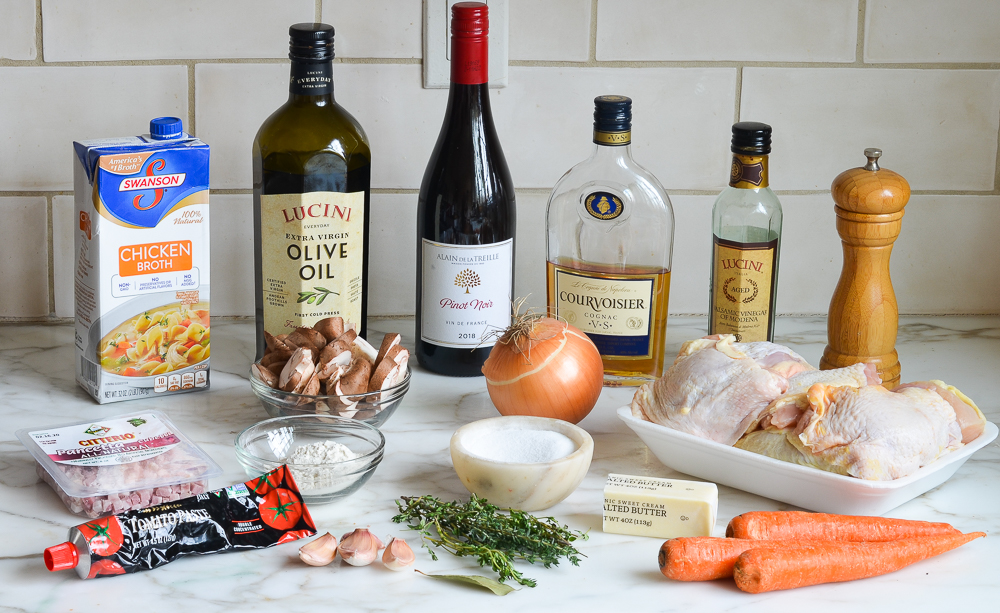
- Pancetta: Infuses the dish with a salty, savory depth. Unlike American bacon, which is smoked, pancetta, or Italian bacon, is cured with salt and spices before being dried. It’s readily available in most supermarkets, either at the deli counter or pre-cut and packaged in the refrigerated gourmet foods section.
- Chicken thighs: While traditional recipes for coq au vin call for a whole cut-up chicken (a coq is an old rooster), I prefer to use only bone-in chicken thighs only. The thighs remain tender and succulent when braised for a long time, whereas white meat/chicken breasts tend to dry out.
- Onion and garlic: These aromatics form the flavor foundation for the stew.
- Cognac: A type of French brandy, cognac adds complex flavor (similar to how it used in other French-style dishes like chicken pot pie, steak au poivre, and turkey gravy).
- Red wine: The key ingredient that characterizes coq au vin, lending the sauce its signature color and robust, fruity flavor. The classic choice for coq au vin is a medium-bodied red wine, such as Burgundy or Pinot Noir.
- Chicken broth: The savory base of the sauce.
- Tomato paste: Contributes a concentrated burst of umami and acidity, deepening the sauce’s richness.
- Fresh thyme sprigs and bay leaf: Infuse the dish with herbal notes.
- Carrots and cremini mushrooms: These classic vegetable additions add sweetness, earthiness, and texture to the dish.
- Butter and all-purpose flour: Combined to form a paste (called beurre manié or kneaded butter) used to thicken the sauce, ensuring it clings to the chicken and vegetables.
- Jump to the printable recipe for precise measurements
Step-by-Step Instructions
To begin, heat the oil in a large (5-qt) Dutch oven or heavy-bottomed pot over medium heat. Add the pancetta (or bacon) and cook until the fat has rendered and the pancetta is crispy, 5 to 8 minutes.
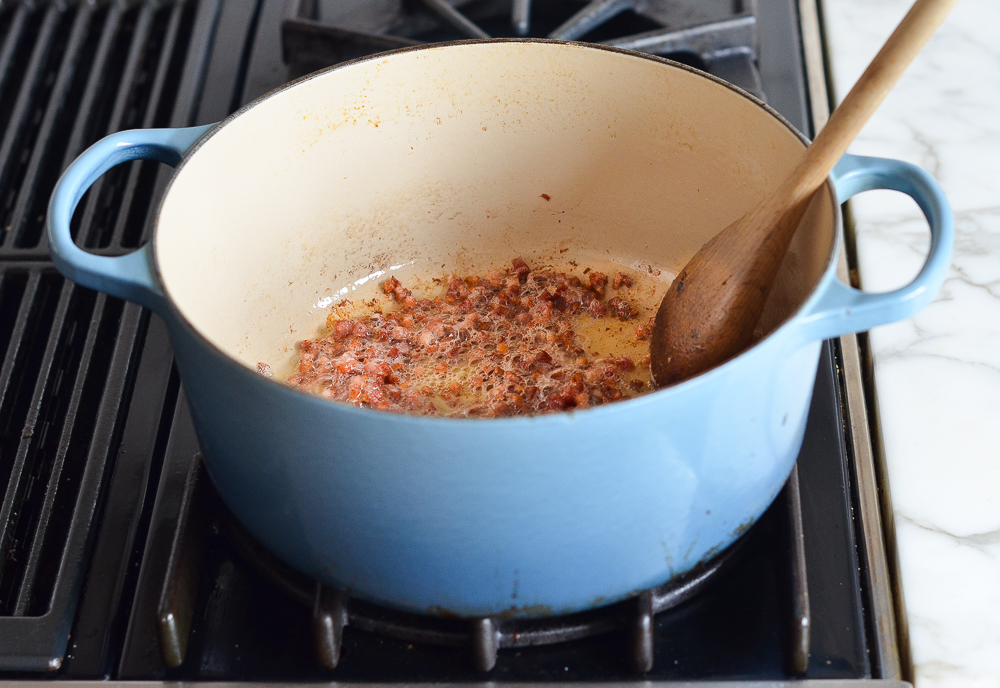
Using a slotted spoon, transfer the pancetta to a paper-towel-lined plate, leaving the fat in the pan. Season the chicken all over with 2 teaspoons salt and ½ teaspoon pepper. Increase the heat to medium-high and brown half of the chicken in a single layer, skin side down, until golden and crispy, about 5 minutes (brown on the skin side only). Using tongs, transfer the chicken to a plate; set aside.
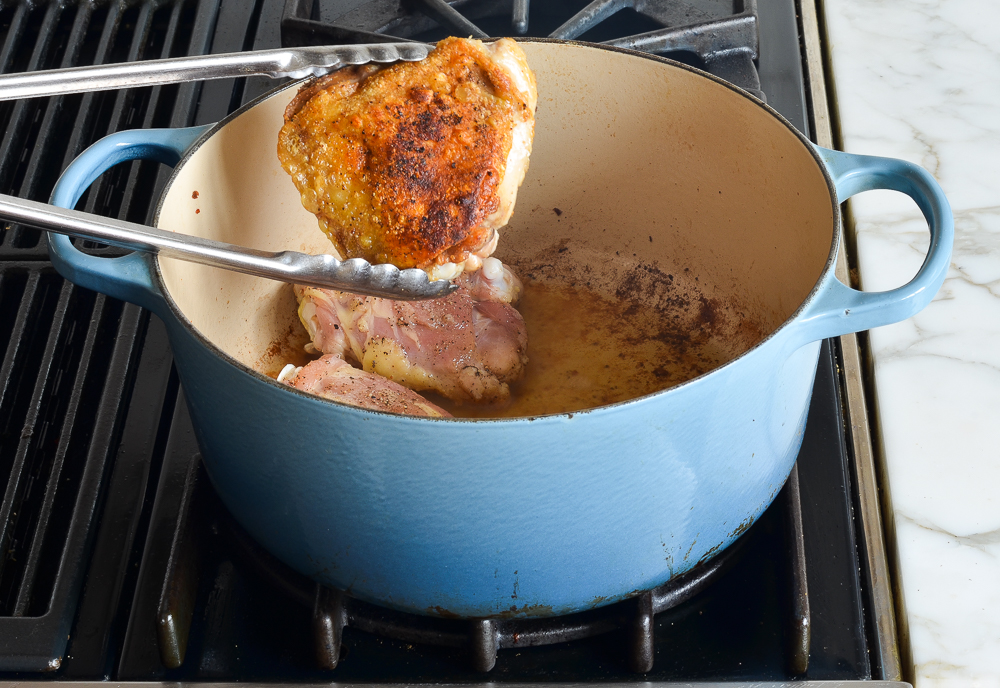
Pour off all but about 2 tablespoons of the fat, then return the pot to the stove and reduce the heat to medium-low. Cook the onions, stirring occasionally, until softened and just starting to brown, 3 to 5 minutes. Add the garlic and cook, stirring constantly, until fragrant, about 1 minute more.
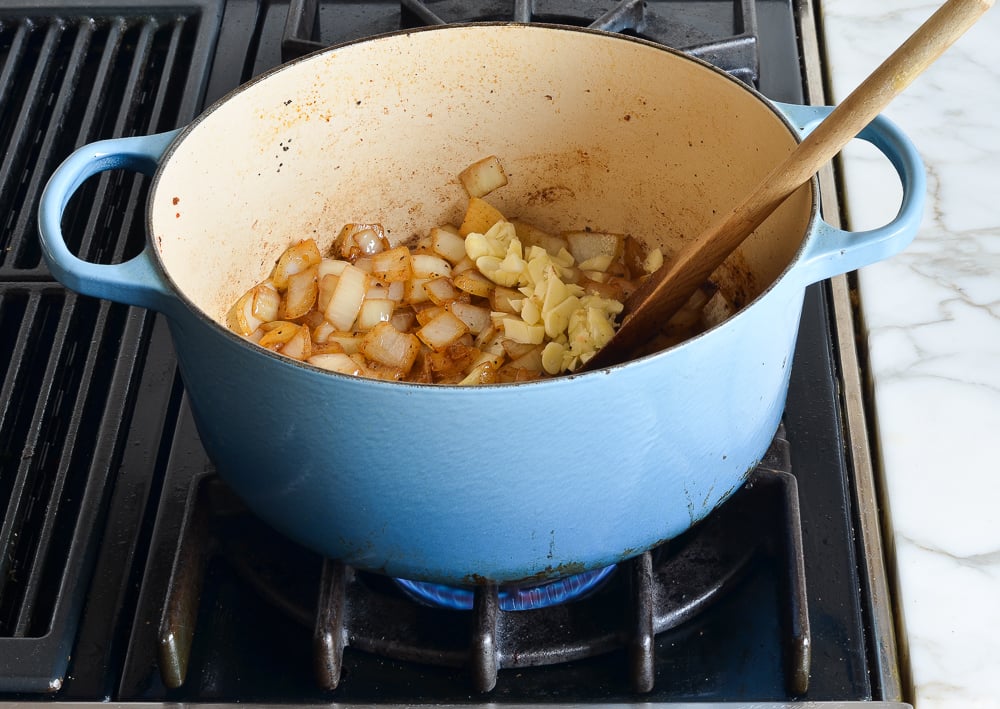
Pour in the Cognac and cook, stirring to scrape the brown bits from the bottom of the pan, until the Cognac has evaporated.
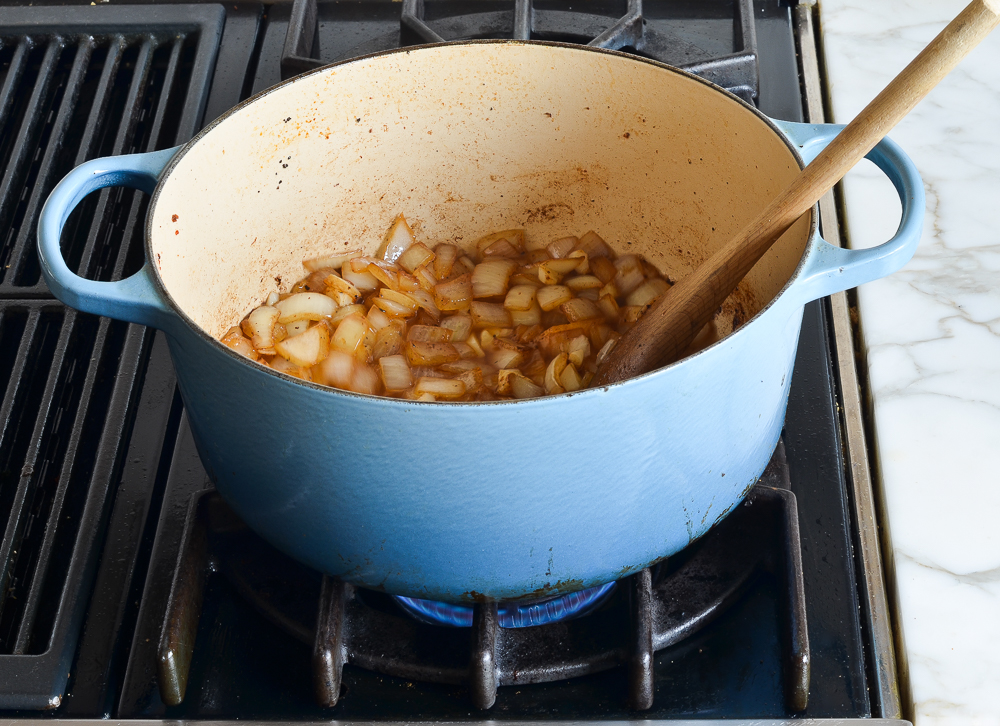
Add the wine, chicken broth, tomato paste, balsamic vinegar, sugar, thyme, bay leaf, and ½ teaspoon salt and bring to a boil.
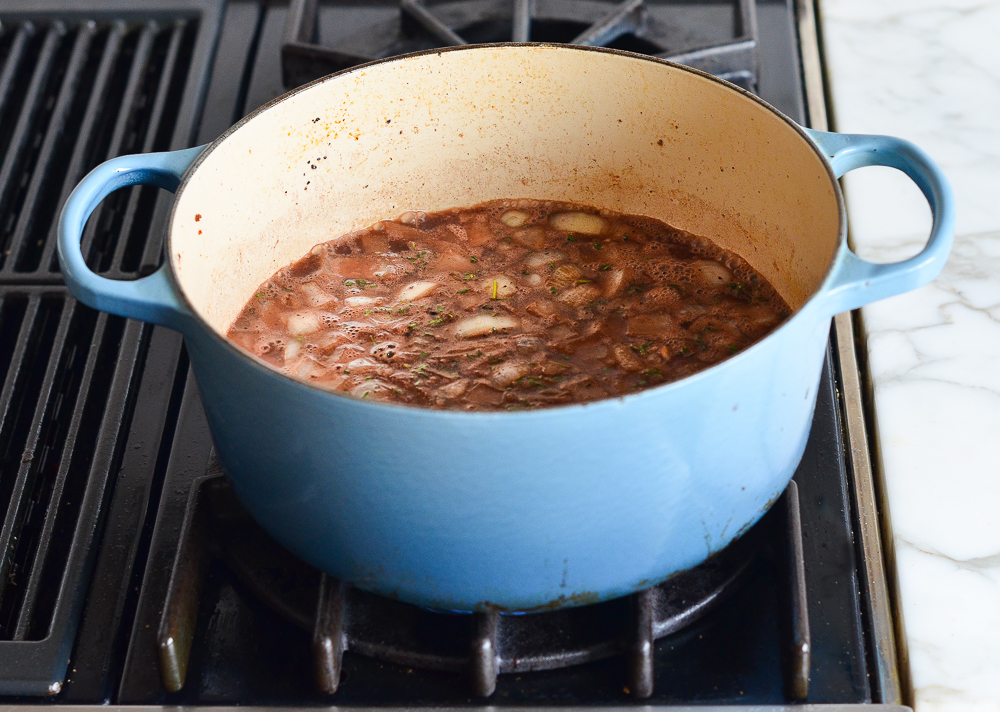
Reduce the heat to medium and gently boil, uncovered, for 15 minutes.
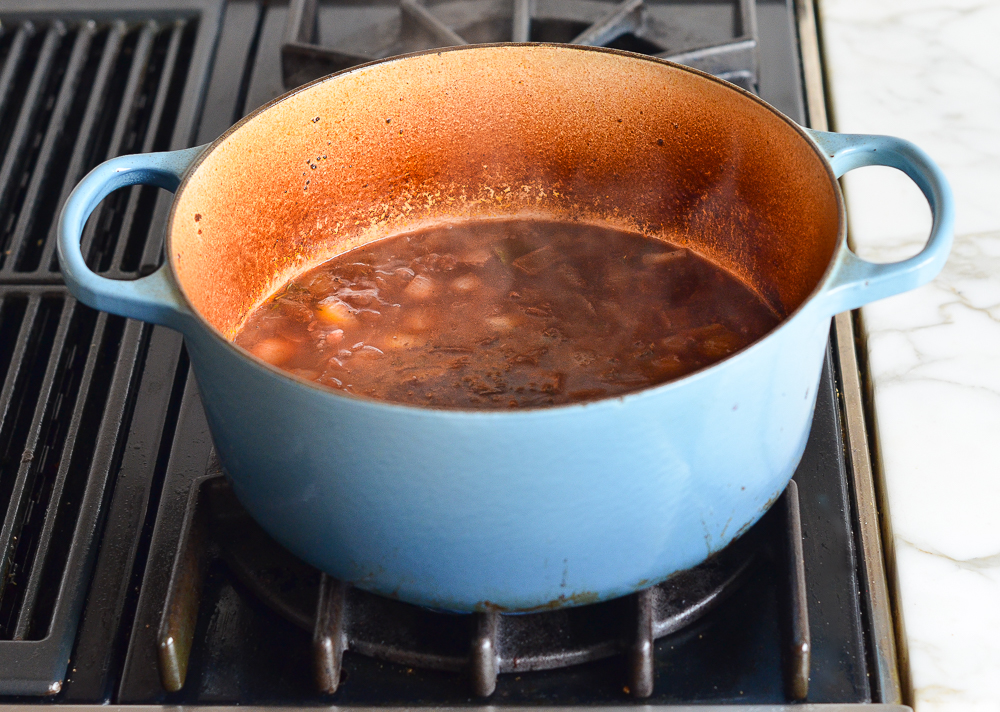
Add the chicken and any accumulated juices from the plate back to the pot, along with the carrots. Bring to a simmer, then cover and cook over low heat for 30 minutes, or until the chicken and carrots are cooked through.
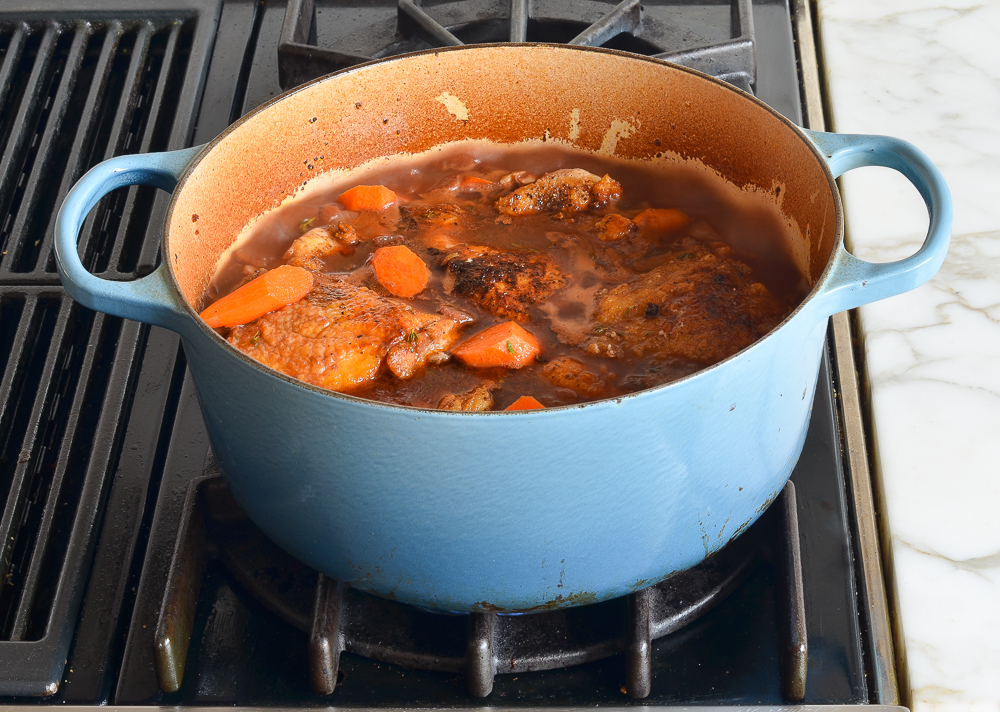
While the chicken cooks, heat the remaining 2 tablespoons of oil in a large skillet over medium heat. Add the mushrooms and 1/4 teaspoon salt and cook, stirring frequently, until the mushrooms are golden brown, about 5 minutes. Set aside.
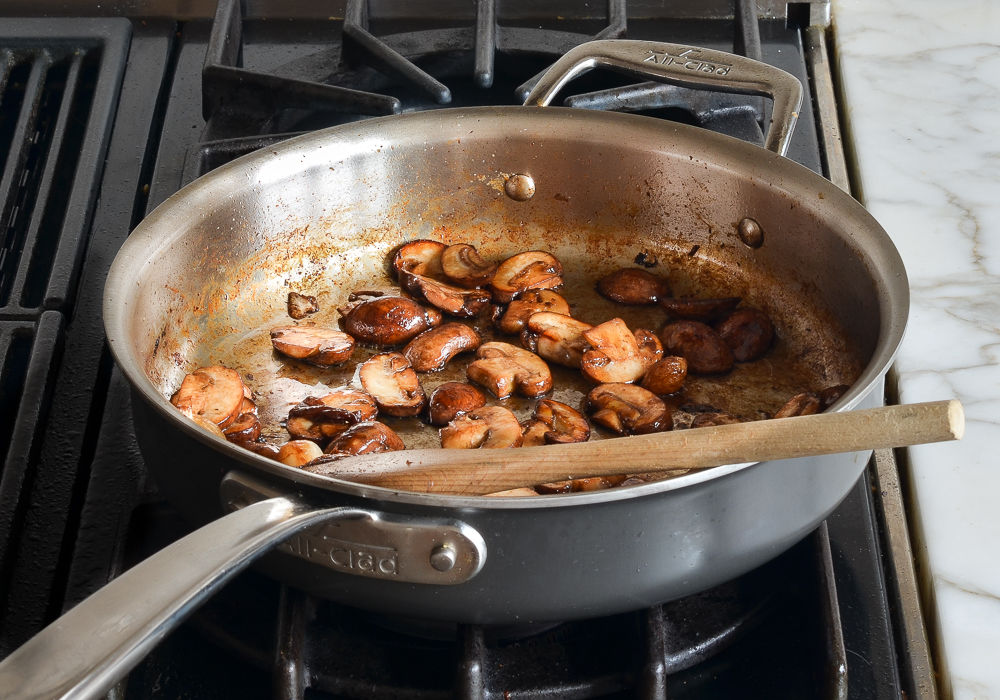
Also while the chicken cooks: In a small bowl, combine the softened butter and flour.
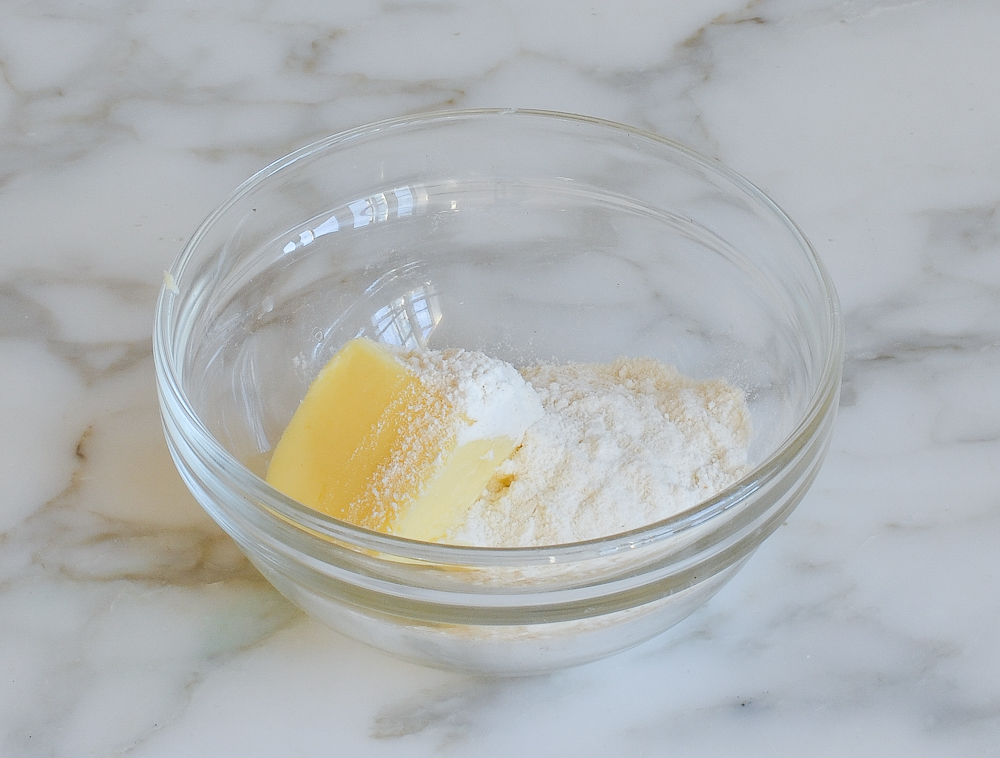
Mash with a spoon to make a smooth paste. In French, this is called a beurre manié (or kneaded butter). Set aside.
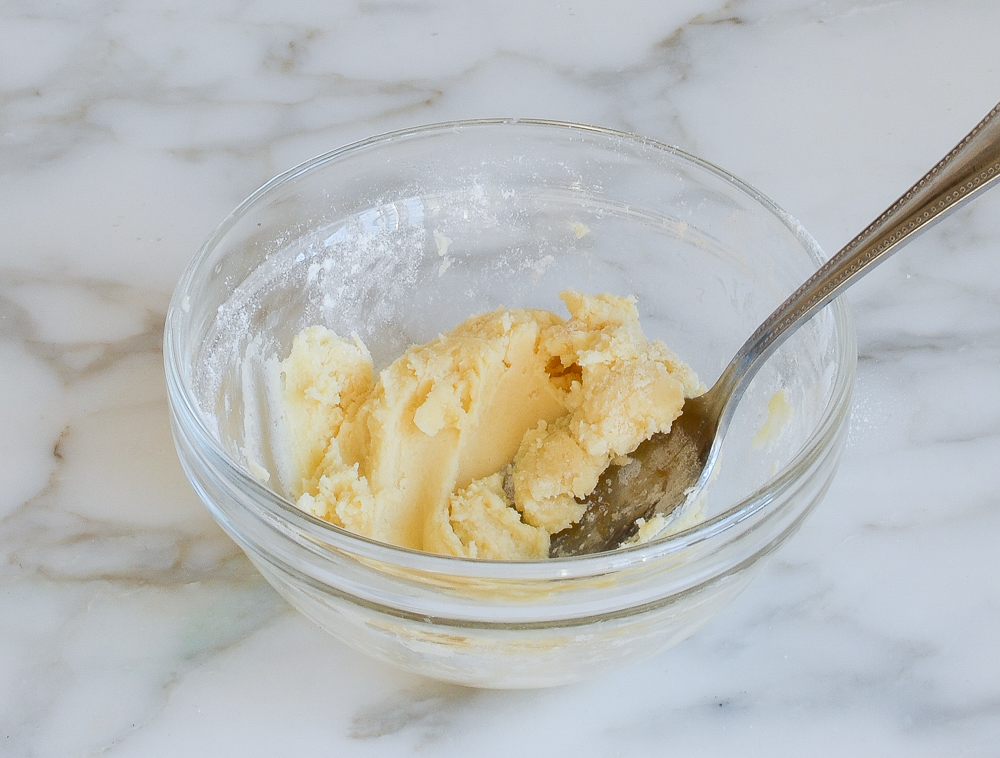
Using a slotted spoon, transfer the cooked chicken to a plate. The wine gives it a purplish hue.
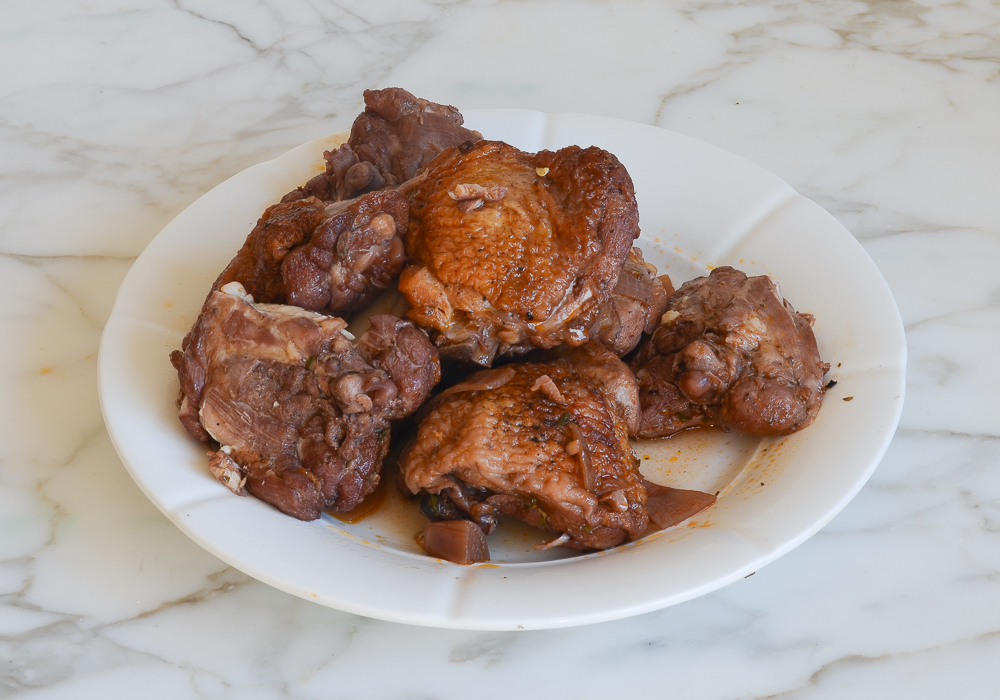
Using a fork and knife, pull the skin off of the chicken (it should slide right off) and discard. The skin has served its purpose by lending flavor to the sauce and protecting the meat from drying out. You don’t have to do remove it, but it’s soggy at this point and I think the dish is more appetizing without it.
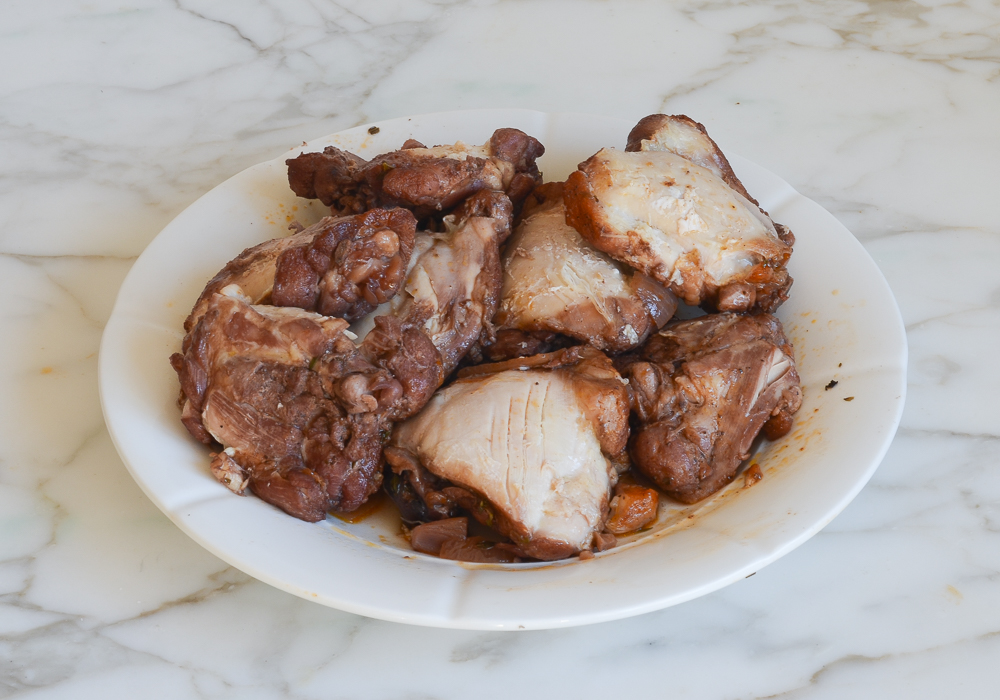
Increase the heat in the Dutch oven/pot to medium and stir in three-quarters of the flour and butter paste.
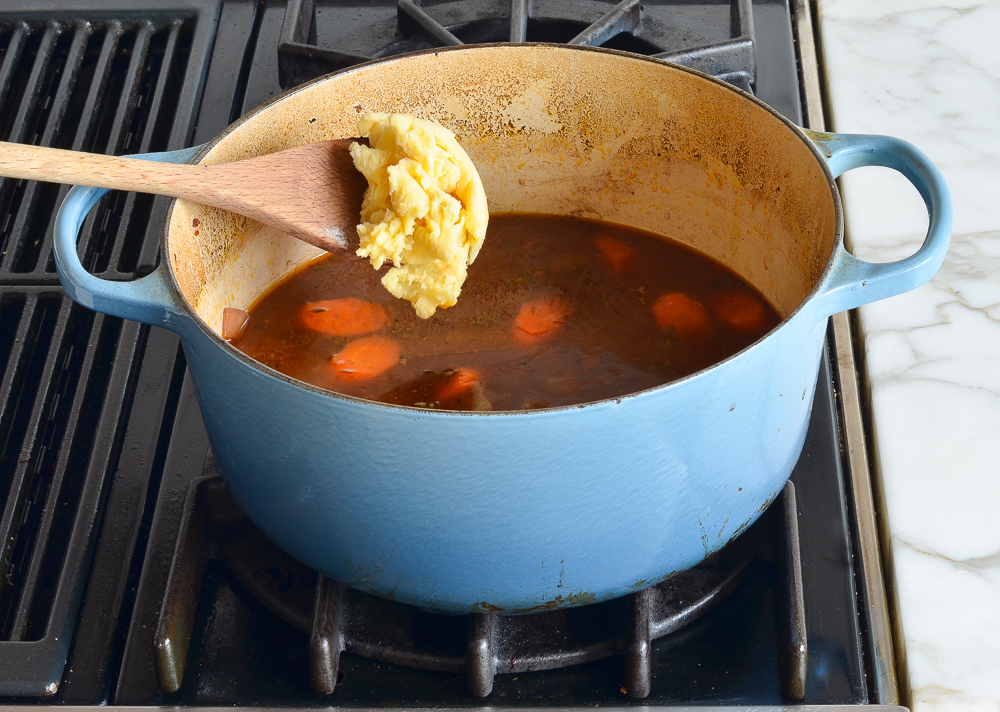
Gently boil until the sauce is thickened, 5 to 7 minutes; add the remaining paste if you’d like the sauce a little thicker. Fish out and discard the bay leaf.
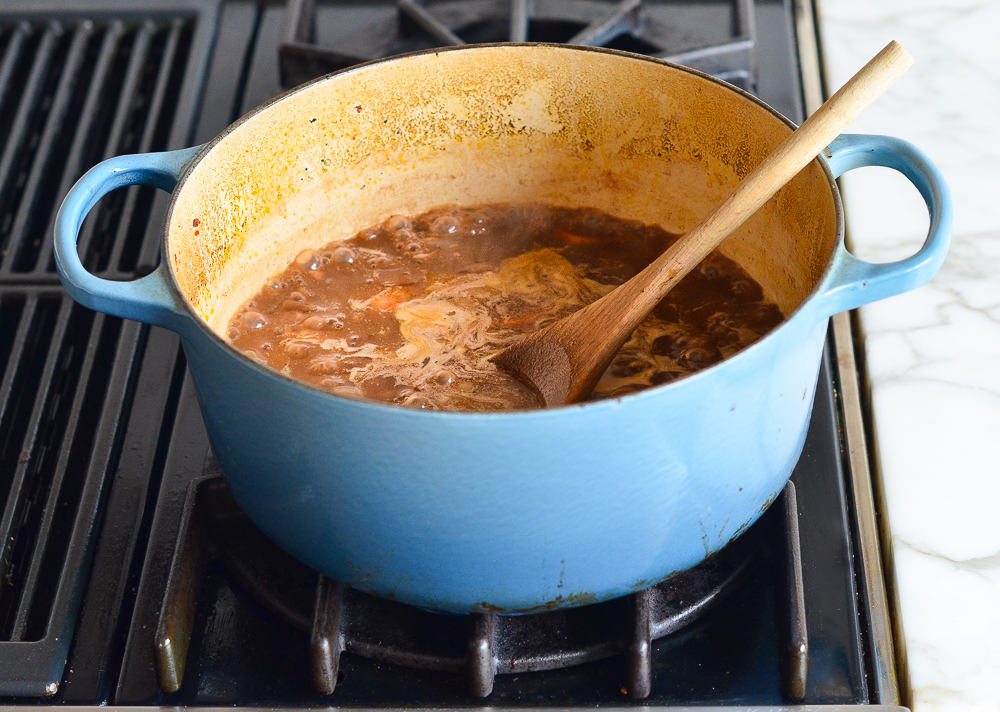
Add the chicken and any accumulated juices back to the pot and simmer, uncovered, for about 10 minutes. Right before serving, stir in the browned mushrooms and pancetta. Taste and adjust seasoning, if necessary. Serve immediately or let cool, chill in the refrigerator, and reheat when ready to serve.
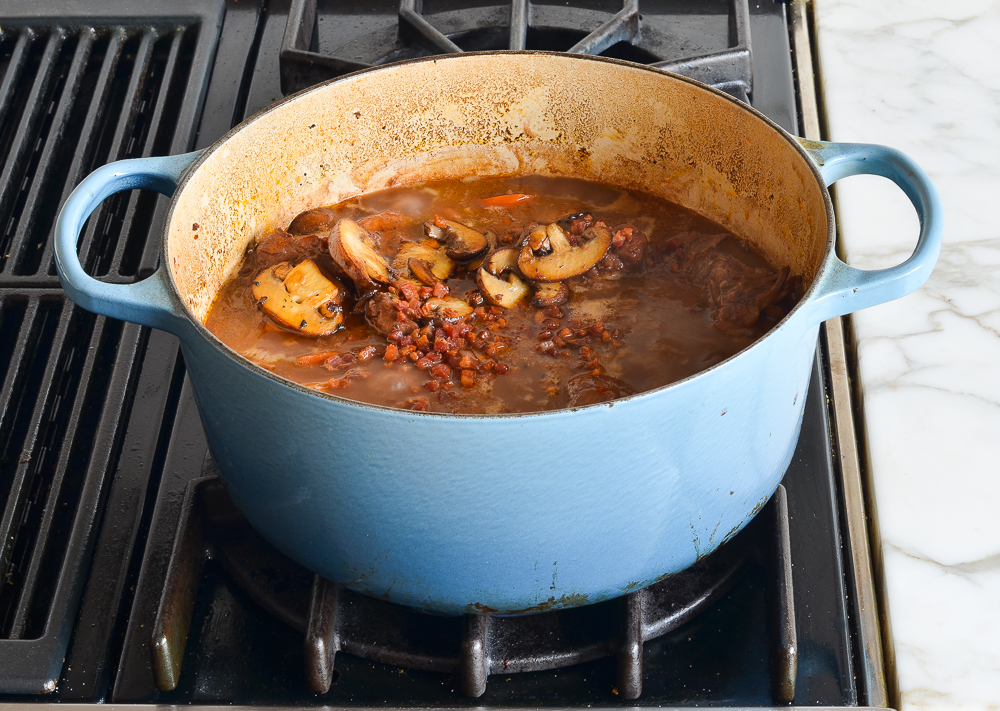
Make-Ahead, Freezing & Storage Instructions
Coq au vin tastes even better when made ahead, as this allows the flavors to meld and deepen. Prepare the dish up to 2 days in advance, cool it to room temperature, and then store it covered in the refrigerator. Reheat gently on the stove, stirring occasionally, until heated through. For best results, store the sautéed mushrooms and crispy pancetta in separate containers in the refrigerator and add right before serving. It can also be frozen in an airtight container for up to 3 months. Thaw overnight in the refrigerator before reheating.
Frequently Asked Questions
The classic choice for coq au vin is a medium-bodied red wine, such as Burgundy or Pinot Noir, but any light or medium-bodied red wine, such as Merlot or Zinfandel, will work. You don’t need to use an expensive bottle; just make sure it’s a wine you’d enjoy drinking—no supermarket cooking wine!
Sure! I don’t include them in this recipe because they can be difficult to find, and I actually prefer the stew without them. If you’d like to add them, brown them in butter and cook them thoroughly before adding them to the finished stew as a garnish.
Video Tutorial
You May Also Like
Coq au Vin
Rich and full of flavor, coq au vin is a classic French stew with tender chicken braised in red wine. It’s the perfect dish to warm you up on a chilly day.
Ingredients
- 3 tablespoons olive oil, divided
- 4 ounces diced pancetta (or bacon)
- 8 bone-in, skin-on chicken thighs (about 4 pounds), trimmed of excess skin (see note)
- Salt
- Freshly ground black pepper
- 1 large yellow onion, roughly chopped
- 4 cloves garlic, roughly chopped
- ¼ cup Cognac
- 2½ cups red wine, preferably Burgundy or Pinot Noir
- 2½ cups chicken broth
- 1½ tablespoons tomato paste
- 2 teaspoons balsamic vinegar
- 1½ teaspoons sugar
- 1 tablespoon fresh thyme leaves (or 1 teaspoon dried)
- 1 bay leaf
- 3 large carrots, peeled and cut into ½-inch chunks on the bias
- 8 ounces sliced cremini mushrooms
- 4 tablespoons unsalted butter, softened
- 4 tablespoons all-purpose flour
Instructions
- Heat 1 tablespoon of the oil in a large (5-qt) Dutch oven or heavy-bottomed pot over medium heat. Add the pancetta and cook until the fat has rendered and the pancetta is crispy, 5 to 8 minutes. Using a slotted spoon, transfer the pancetta to a paper-towel-lined plate, leaving the fat in the pan.
- Season the chicken all over with 2 teaspoons salt and ½ teaspoon pepper. Increase the heat to medium-high and brown half of the chicken in a single layer, skin side down, until golden and crispy, about 5 minutes (brown on the skin side only). Using tongs, transfer the chicken to a plate; set aside. Repeat with the remaining chicken. Pour off all but about 2 tablespoons of the fat.
- Return the pot to the stove and reduce the heat to medium-low. Add the onions to the pot and cook, stirring occasionally, until the onions are softened and just starting to brown, 3 to 5 minutes. Add the garlic and cook, stirring constantly, until fragrant, about 1 minute more. Add the Cognac and cook, stirring to scrape the brown bits from the bottom of the pan, until the Cognac has evaporated. Add the wine, chicken broth, tomato paste, balsamic vinegar, sugar, thyme, bay leaf, and ½ teaspoon salt. Bring to a boil, then reduce the heat to medium and gently boil, uncovered, for 15 minutes.
- Add the chicken and any accumulated juices from the plate back to the pot, along with the carrots. Bring to a simmer, then cover and cook over low heat for 30 minutes, or until the chicken and carrots are cooked through.
- While the chicken cooks, heat the remaining 2 tablespoons of oil in a large skillet over medium heat. Add the mushrooms and ¼ teaspoon salt and cook, stirring frequently, until the mushrooms are golden brown, about 5 minutes. Set aside.
- Also while the chicken cooks: In a small bowl, mash the softened butter and flour to make a smooth paste. Set aside.
- Using a slotted spoon, transfer the cooked chicken to a plate.
- Increase the heat in the Dutch oven/pot to medium and stir in three-quarters of the flour and butter paste. Gently boil until the sauce is thickened, 5 to 7 minutes; add the remaining paste if you'd like the sauce a little thicker. Fish out and discard the bay leaf.
- Using a fork and knife, pull the skin off of the chicken and discard.
- Add the chicken and any accumulated juices back to the pot and simmer, uncovered, for about 10 minutes. Right before serving, stir in the browned mushrooms and pancetta. Taste and adjust seasoning, if necessary, then serve.
- Note: Sometimes chicken thighs have excess skin and/or fat. Before cooking, using kitchen shears, trim any skin that extends farther than the edges of the chicken thigh, and snip off any excess fat.
- Make-Ahead Instructions: Let cool to room temperature and then store in the refrigerator for up to 2 days. Reheat over medium-low heat on the stovetop before serving. (For best results, store the sautéed mushrooms and crispy pancetta in separate containers in the refrigerator and add before serving.)
- Freezer-Friendly Instructions: This can be frozen for up to 3 months. Before serving, defrost the stew in the refrigerator for 24 hours and then reheat on the stovetop over medium-low heat until hot.
Pair with
Nutrition Information
Powered by ![]()
- Per serving (4 servings)
- Serving size: 2 chicken thighs
- Calories: 1,470
- Fat: 99 g
- Saturated fat: 30 g
- Carbohydrates: 32 g
- Sugar: 11 g
- Fiber: 3 g
- Protein: 75 g
- Sodium: 2,139 mg
- Cholesterol: 432 mg
This website is written and produced for informational purposes only. I am not a certified nutritionist and the nutritional data on this site has not been evaluated or approved by a nutritionist or the Food and Drug Administration. Nutritional information is offered as a courtesy and should not be construed as a guarantee. The data is calculated through an online nutritional calculator, Edamam.com. Although I do my best to provide accurate nutritional information, these figures should be considered estimates only. Varying factors such as product types or brands purchased, natural fluctuations in fresh produce, and the way ingredients are processed change the effective nutritional information in any given recipe. Furthermore, different online calculators provide different results depending on their own nutrition fact sources and algorithms. To obtain the most accurate nutritional information in a given recipe, you should calculate the nutritional information with the actual ingredients used in your recipe, using your preferred nutrition calculator.

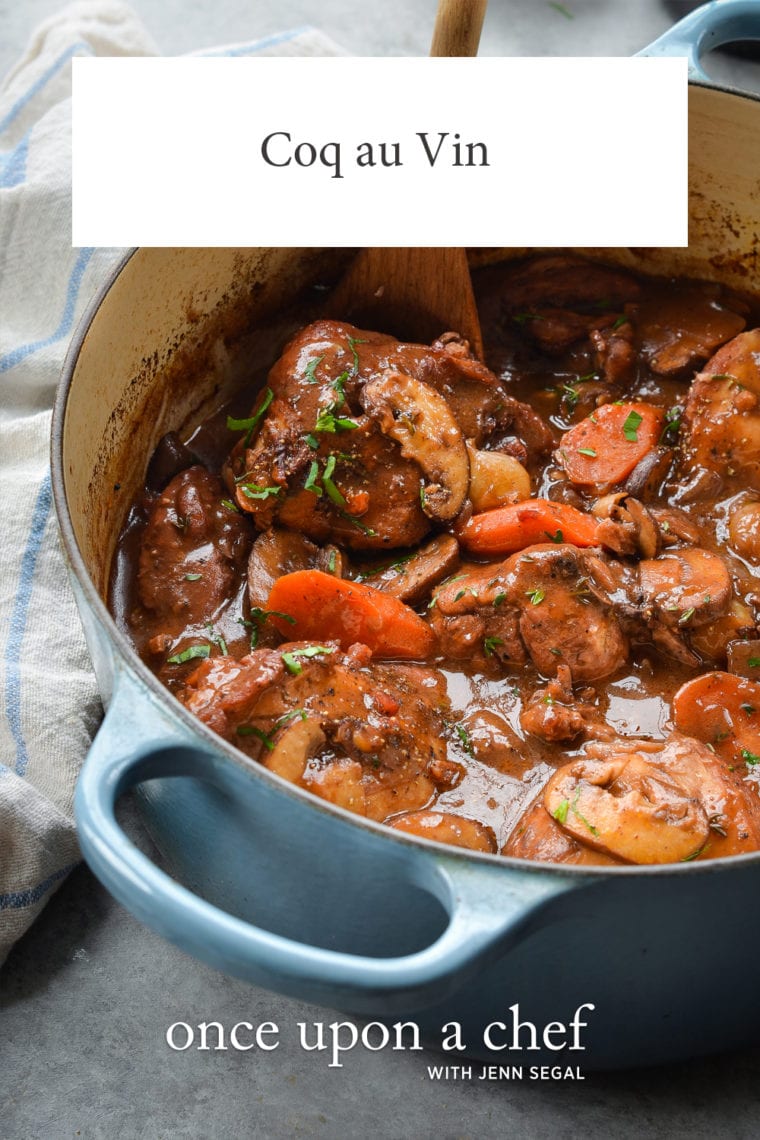
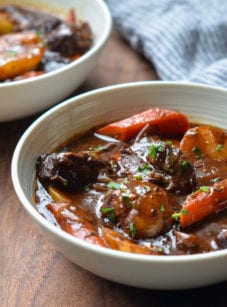
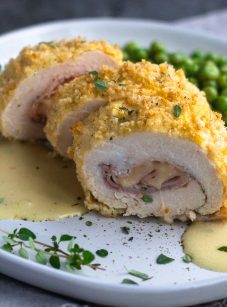
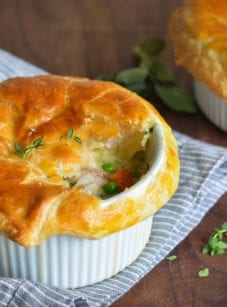

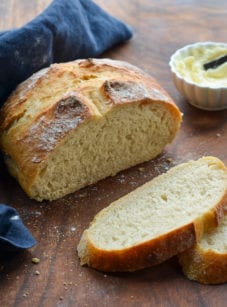
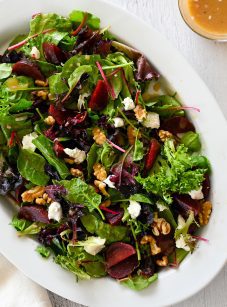
Question: we really only like boneless chicken breasts. This sounds delicious could I use only boneless chicken breasts? If so what would you do differently
PS I love your recipes
Hi Cheryl, I don’t recommend it for this recipe – so sorry!
This was insanely good!!! I served it over buttered egg noodles and it was absolutely delicious. Definitely a meal worth the time it takes to make it!
RE : Your comment that Coq = old rooster……Once upon a time, I got it my mind that this recipe was probably a way to make use of the meat of a rooster, which would be very tough. (I have seen some recipes that call for marinating the bird in red wine for a day…. I think to soften the meat…..) So, I went to a very well known poultry shop near us, where we had bought fresh turkey, chicken, duck, etc. I told the person behind the counter what I wanted, ie, a rooster. He paused and mused a few seconds, then nodded his head and said “rooster, roaster..”, “the roasters are roosters and the fryers are hens.”, with a smile. I swallowed my shock, and simply asked to speak with one of the owners, who explained to me that “the way we raise them these days, we don’t know which are the males and which are the females.” I don’t think I bought anything that day, (I have since) but I was shocked!! I am guessing that the use of hormones or other additives play such a roll in the production of chicken that we have lost that good old sex appeal! Or, maybe they just castrate the males, I don’t know. My question is, would you ever make this dish with an actual rooster? I know of a very few poultry shops where I could actually get one. It would be fun to see what the original (“historically informed”?) preparation tased like !! Thank you again for a great website!! Jack
That’s a funny story! I’ve never made it with rooster and I’m not sure how it would turn out. Considering this recipe is a bit of an undertaking, I’d probably stick with the thighs. 🙂
Hello,
I’m going to be making this recipe in a couple of days (Saturday, May 14th) and I’m wondering if I can substitute cooking sherry for the cognac?
Many thanks!
Hi Chris, I wouldn’t recommend cooking sherry for this. I stay away from cooking wines as they have a lot of additives and salt and can impact the flavor of the dish. The cognac adds depth of flavor to the dish but if you don’t have it on hand, you can omit it. Hope that helps!
Hi Jenn, I appreciate your speedy response! I’ll omit. 🙂
Hello Jenn,
I really enjoyed making this. Two questions, first what if I used another 2.5 cups of wine instead of the broth, would I need any changes to the other ingredients? Would you recommend? Second, I have seen other recipes that call for a long slow cook. Any thoughts here? I guess that’s more than two questions…
Thanks, Keith
Hi Keith, if you use additional wine instead of broth, you wouldn’t need to make any additional changes. Keep in mind that the sauce will taste very wine-y, and this recipe already cooks kind of slow and low and I don’t think you need to go any slower as the flavors really have a chance to develop fully in the time provided in the recipe. Hope that helps!
Hello Jenn,
Thank you again for your advice and taking the time to respond to everyone. As mentioned, I tried the recipe using broth, cooking as described in one day. Next, the only change made was substituting the broth quantity for wine, using the storage over night, and finishing the next day with mushrooms/pancetta added before serving as you recommended. Absolutely, both were worth every minute of work and every bite taken. It was a bit embarrassing to receive so many compliments. Leftovers are incredible.
Best, Keith
Thanks for the update, Keith, and so glad came out well with your tweaks. And you comment about getting so many compliments made me laugh! 🙂
Hi Jenn,
Can I add the mushrooms earlier? I’m trying to make this ahead of time.
Thanks,
Trish
They’re best if the mushrooms and pancetta and stored separately and added right before serving, but it’s doable to add them ahead. Hope you enjoy!
Hi Jenn, looking forward to making this – can I substitute the chicken thighs with a whole chicken without making other changes?
Hi Qian, Yes, it’s fine to use a cut up chicken here. Just keep an eye on the white meat to make sure it doesn’t overcook. Please LMK how it turns out!
This was well worth the two hour effort. Wow. Such flavor!
I have just sent a comment on your fantastic recipes, I forgot to ask if you have one for lamb shanks. If you have could you send, many thanks
Hi Derek, As of now, I don’t have a proven recipe of my own for lamb shanks – I’m sorry! I’ll have to add that to my list of recipes to potentially develop. Thanks for the suggestion as I’m always looking for new inspiration!
I have now tried both Coq au vin and beef stew, absolutely fantastic both, keep sending recipes on line, they have been the BEST ever. Thank you